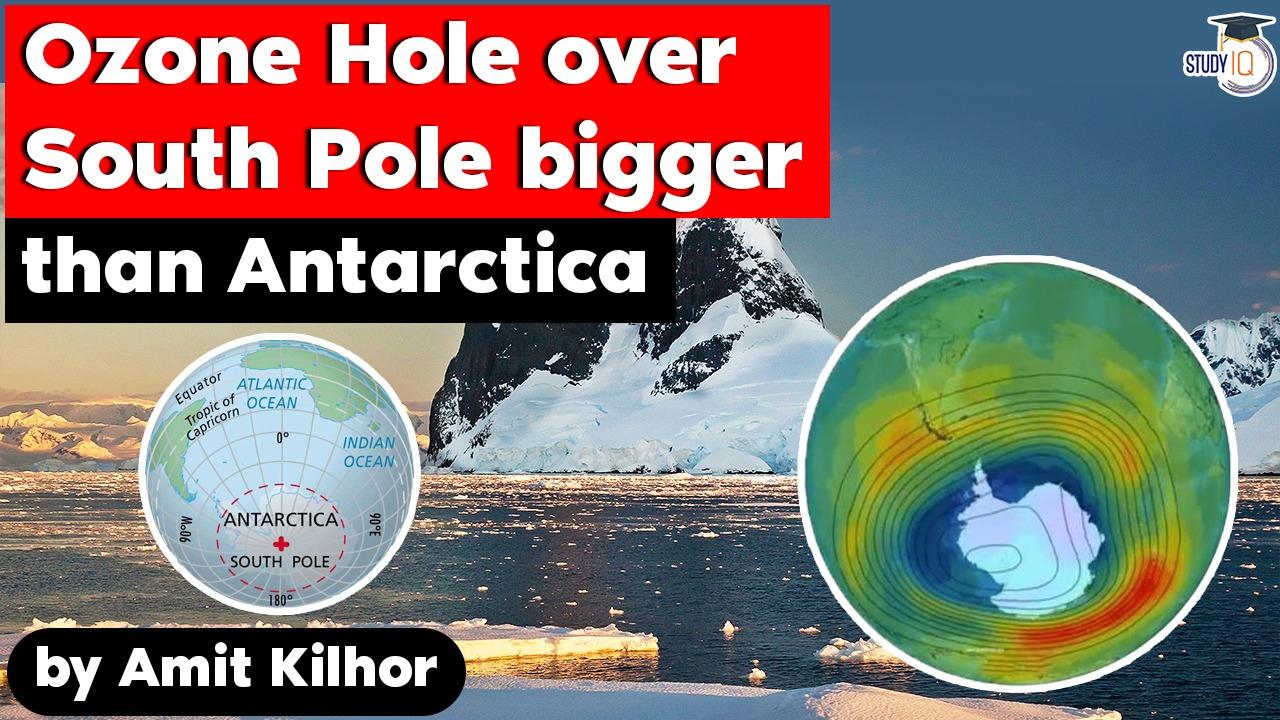Table of Contents
OZONE HOLE
- The hole in the ozone layer over the Souther Hemisphere is now larger than Antarctica as it grew considerably in the past two weeks, scientists at the European Union’s Copernicus Atmosphere Monitoring Service (CAMS) said .

- CAMS constantly monitors earth’s ozone layer, tracking the formation and evolution of the annual chemical destruction of ozone that leads to the development of the hole.
- Earth’s protective ozone layer depletes and forms a hole over the South pole every Spring due to the human-made chemicals.

- During the Southern Hemisphere spring season from August to October, the ozone hole forms annually over the Antarctic, reaching a maximum between mid-September and mid-October.
- the primary cause of ozone depletion is the presence of chlorine-containing source gases (primarily CFCs and related halocarbons). In the presence of UV light, these gases dissociate, releasing chlorine atoms, which then go on to catalyze ozone destruction.
- The “ozone hole” is more of a depression, less “a hole in the windshield”. The ozone does not disappear through the layer, nor is there a uniform “thinning” of the ozone layer.
- CAMS scientists have been closely monitoring the development of this year´s ozone hole over the South Pole, which has now reached an extent larger than Antarctica.
- After a rather standard start, the 2021 ozone hole has considerably grown in the last two weeks
- In 1987, the Montreal Protocol was signed which led to a ban on a group of chemicals called halocarbons that contain bromine which has high ozone-depleting potential (ODP).
- A number of commonly used chemicals like chlorofluorocarbons (CFCs) and hydrochlorofluorocarbons (HCFCs) have been to be extremely damaging to the ozone layer.
- CFCs have been banned in 197 countries around the world.

- Since the ban on so-called halocarbons the ozone layer has shown signs of recovery, but it is a slow process and it will take until the 2060s or 70s for a complete phasing-out of the depleting substances.
- During recent years with normal weather conditions, the ozone hole has typically grown to a maximum of 20 million sq km
- Montreal Protocol have each been ratified by 196 nations and the European Union, making them the first universally ratified treaties in United Nations history.
- Due to its widespread adoption and implementation, the Montreal Protocol has been hailed as an example of exceptional international cooperation, with Kofi Annan describing it as “perhaps the single most successful international agreement to date
- The Dobson Unit is the most common unit for measuring ozone concentration.
- One Dobson Unit is the number of molecules of ozone that would be required to create a layer of pure ozone 0.01 millimeters thick at a temperature of 0 degrees Celsius and a pressure of 1 atmosphere (the air pressure at the surface of the Earth).
- Ozone in the atmosphere isn’t all packed into a single layer at a certain altitude above the Earth’s surface; it’s dispersed. Even the stratospheric ozone known as “the ozone layer” is not a single layer of pure ozone.
- It is simply a region where ozone is more common than it is at other altitudes. Satellite sensors and other ozone-measuring devices measure the total ozone concentration for an entire column of the atmosphere. The Dobson Unit is a way to describe how much ozone there would be in the column if it were all squeezed into a single layer.
Latest Burning Issues | Free PDF






















 WhatsApp
WhatsApp